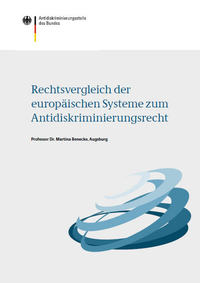Comparison of the Implementation of EU Equality Directives
- Factsheet on the research project -
Authors: Prof. Dr. Martina Benecke, published by the Federal Anti-Discrimination Agency (FADA) Year of publication: 2010
Brief overview
The expert opinion compares and evaluates the implementation of the European Equality Directives in the Member States of the European Union.
Main results
European law as the basis of the General Equal Treatment Act - AGG
The European Union has obliged its Member States to include the protection from discrimination as stipulated in four Equality Directives into national labour and private law. Each Directive protects different personal aspects in various spheres of life:
| Directive | Ground for Discrimination | Sphere of life |
Anti Racism Directive 2000/43/EC of 29.06.2000 | Racial or ethnic origin | Employment and occupation Access to and provision of goods and services which are available to the public |
| Framework Directive 2007/78/EC of 27.11.2000 | Religion or belief, disability, age or sexual orientation | Employment and occupation |
| Recast Directive 2006/54/EC of 5.07.2008 (replaced Directive 2002/73/EC of 23.09.2002) | Gender | Employment and occupation |
| Gender Directive 2004/113/EC of 13.12.2004 | Gender | Access to and supply of goods and services |
All of these four Equality Directives were transposed into German law by means of the General Equal Treatment Act (Allgemeines Gleichbehandlungsgesetz - AGG). It entered into force on 18 August 2006.
Practical experience so far
- By 2010, only a few deficits remained regarding the implementation of the Equality Directives. Indeed, most EU Member States have overdelivered on the Directive. Most deficits have been remedied.
- Legal action, by contrast, has comparatively scant success across all Member States. In Great Britain, the success rate is 10 per cent, in Hungary it is three per cent.
- The legislative procedure has triggered a discussion over discrimination in the Member States and raised public awareness of the issue.
The differences
Legislative implementation
States like Germany, Estonia and the Netherlands have transposed the Directives by means of a single anti discrimination law. Other states have adopted several anti discrimination laws, among them Belgium, Austria and Denmark.
Statutory discrimination grounds
Several East and West European countries have included additional grounds for discrimination such as illness, political or union activities, civil status and social status. Mainly East European countries have decided to draw up non-conclusive lists of discrimination grounds.
Legal consequences
Major differences exist with regard to sanctions for con-compliance. In North and West European countries, compensation are common while South European countries have opted for penal law approaches.
Anti discrimination organisations
Large differences exist when it comes to the participation of such organisations in legal proceedings. Only a small number of countries allows these organisations to act in court “on behalf of“ discrimination victims.
Anti discrimination agencies
Member States differ fundamentally with regard to the number, size, remit, powers, legal nature and name of the agencies established. Agencies in East European countries enjoy sweeping legal competencies thanks to their quasi-judiciary functions and powers.
Types of implementation
Approaches to implementation fall into three geographical groups that can be dubbed as follows:
The North West European Group
comprises the Nordic Member States, the United Kingdom, the Benelux countries, Germany, Austria and France. They are characterised by a “proficient” implementation.
The South European Group
comprises Portugal, Spain, Italy, Malta, Greece and Cyprus. Their approach to implementation can be termed as “reluctant“.
The East European Group
comprises the Baltic countries, Poland, Bulgaria, Romania, Slovenia, the Slovak Republic, the Czech Republic and Hungary. Their mode of implementation can be termed as “ambitioned“.
Options for action
The author opposes a non-conclusive list of discrimination grounds since, inter alia, it relativises the care required in selecting grounds and the rationale for their inclusion. In respect of individual grounds, the author concludes the following:
- State of health
An advantage is the fact that the difficult distinction from disability can be avoided. However, the protection of illness and state of health only makes sense when embedded in a balanced system of justifications. - Civil status
If a targeted family support scheme is an option as a positive measure, the inclusion of this ground is useful. - Social status
It has practical relevance in civil law. Overall, the risks of relativisation and legal uncertainty would outweigh the benefits.

